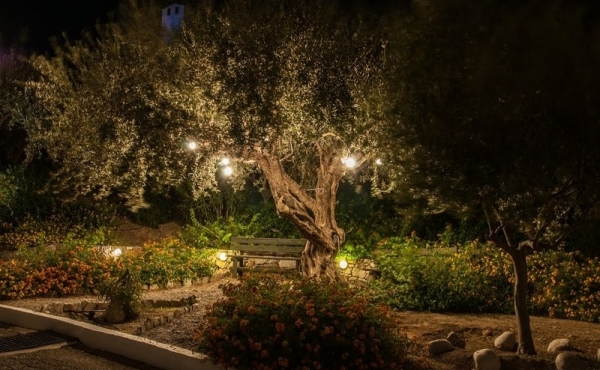
26 February 2025
How to light an olive tree: the Amlux answer
The best solutions for lighting your olive tree and making it a true work of art
For those who have a beautiful outdoor garden - be it private or a company communal space - the olive tree is an ideal and, for this reason, increasingly popular solution. To ensure that the visual effect is at its best, even in the evening and at night, choosing the right lighting for the olive tree is absolutely essential.
This makes it possible to transform an already very beautiful and decorative plant into a true work of art. The olive tree is in fact a plant with roots that are not too deep; this also allows it to be planted in pots, so it can also be used in gardens and green spaces that are not too large. Being a very robust and resilient plant, it is perfect for private gardens and for decorating terraces.
Therefore, it is good to take care of it and try in every way to make the best use of it. An outdoor lighting system, designed especially for olive trees, can allow those who have these beautiful plants to enjoy them to the fullest.
Some preliminary notes on tree lighting
There are certain factors and elements to consider, in general, when it comes to installing a lighting system in the garden, and especially when it is dedicated to a plant as beautiful, elegant and imposing as the olive tree.
First of all, of course, the identification of light points. The outdoor space, the plants and in particular the olive tree, must be illuminated in the right amount. The lighting points must therefore respect tasteful and aesthetic as well as functional factors.
In particular, to illuminate trees in the garden, such as olive trees, it is good to take into account certain elements that influence the final effect, such as:
- The trunk. Shape and size influence the type of lighting required. Depending on whether it is thin or solid, smooth or, as is often the case, beautifully twisted and faceted like that of the olive tree, one can choose lighting that enhances this character or not (and which can also be modulated, if necessary).
- The foliage. Plants can have different leaves and foliage, more or less thick or sparse: they can be spherical, columnar, umbrella and palm-shaped. Each has its own peculiarities and requires a certain direction of light. Olive trees, especially garden trees, have small leaves and generally quite sparse crowns that allow light to pass through, and this is a factor that must be taken into account.
- Growth. The lighting of the garden plant must follow its development in order to maximise its appearance. This is why adjustable lighting may be the best choice to follow its development, especially if the plant is bought and planted ‘in growth’.
- The position of the plant in the external context, of course, and the possible presence of other architectural elements.
- The seasons. In summer, the tree blossoms, greens and has more leaves, while in winter the bare branches give it an entirely different appearance. This problem is of course avoided by adopting an olive tree, since it is an evergreen and has a characteristic umbrella shape that it retains even during pruning.
Which types of olive trees are most suitable?
There are many varieties of olive trees, some of which are particularly suitable as ornamental garden plants. The most widely used and appreciated quality for oil, in Italy, is the moraiolo olive; but in the case of garden olive trees, it is better to opt for different solutions.
The Bianchera olive tree, the Nostrale di Rigali, is a very resilient quality, able to withstand even extreme and windswept climates. The table varieties, Nocellara, Ascolana, Santa Caterina and Sant'Agostino, are particularly suitable for cultivation in the garden.
One olive tree that has been making waves recently is the Japanese olive tree. Not only bonsai: there are different types of Japanese olive trees (which are cultivated and developed in various prefectures) that are also gaining a name for themselves on the Italian and international market for their splendid decorative ability.
The ideal solution: LED spotlights
So the main question is: how to light an olive tree? The perfect answer for all needs does not exist, given the wide degree of customisation and factors to consider that we mentioned earlier. But, the best and most versatile answer is: with LED spotlights.
The use of LED technology in outdoor lighting is becoming increasingly popular in all gardens. LED lights in particular are proving to be very useful for lighting olive trees. This is because of several advantages:
- An average life of 50000 hours
- A high luminous efficiency that reduces consumption by up to 10 times compared to incandescent lighting
- Accuracy: a great advantage is the possibility to have, thanks to the use of LED modules and lenses as secondary optics, a perfect light beam, without blurring, of the perfect width and intensity to illuminate the olive tree, exactly where it needs to be illuminated.
- Consideration must also be given to the degree of protection and the materials with which the spotlights, lights and flaps are constructed. They must be reliable materials and tin-plating to withstand the weather.
So how should an olive tree be illuminated in its different parts? Of course, as we said, it is always good to study the specific case. In general terms:
- Lighting the olive tree trunk. The most classic, aesthetically functional and effective solution is to place an LED spotlight that illuminates from the bottom upwards, so as to highlight the bark and its particular texture. Generally between 1 and 3 spotlights can be placed, depending on the viewpoint.
- Trunk and crown lighting. This is the solution that allows the entire plant to be lit organically and consistently, and gives the tree a more natural appearance. For this, additional adjustable LED spotlights can be positioned, even on all sides, to emphasise the foliage and the volume of the leaves.
How much light is needed?
Depending on the type chosen, the olive tree can reach up to 20 metres in height! However, as you can imagine, plants of this height and size are rarely found in gardens or private homes. These generally do not go above 4-5 metres.
As can be guessed, the taller the olive tree, the more light it needs to be illuminated. This is how we generally proceed with light output according to the height of the olive tree:
- 1 metre: 500 - 1500 Lumen
- 2 metres: 1000 - 2000 Lumen
- 3 metres: 1500 - 2500 Lumen
- 4 metres: 2000 - 3000 Lumen
- 5 metres: 2500 - 3500 Lumen
- 6 metres: 3000 - 4000 Lumen
The Amlux solution
Amlux designs and supplies a complete range of lighting solutions for outdoor spaces, gardens, as well as specific systems for plants and even olive trees.
A particularly suitable and effective product for lighting olive trees in the garden is the Ariel LED floodlight. Its slim and elegant LED technology with a good IP65 protection rating makes it ideal for many applications outdoors and in the presence of plants such as olive trees. It can be easily directed, is thin and light, modular and versatile, and is perfect for directing the best lighting for the trunk and foliage of olive trees.
If you need further details on spotlights or olive tree lighting systems, or if you need advice for your project, please do not hesitate to send us your doubts and questions via the form in the contact section. We will respond as soon as possible!








